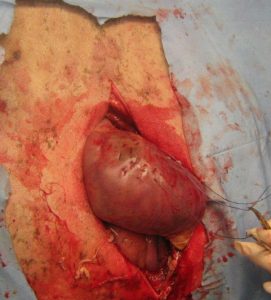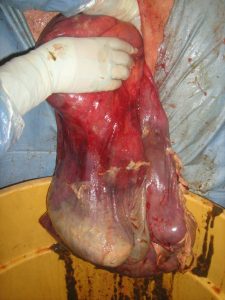FA GI Topics
Abomasal volvulus
An RDA can progress to a volvulus. Generally the abomasum flips up (forming an RDA) and then rotates toward the tail (counterclockwise as viewed from the right side). This compresses the abomasum so no fluid can leave either via the pylorus or to the omasum. Vessels can also be compressed, leading to ischemic necrosis. Occasionally, the omasum is involved in the twist. The torsed abomasum can contain gallons of fluid. Affected cows can become very shocky and can die from cardiovascular collapse. The distension can lead to problems with abomasal contraction even if the volvulus is corrected.
Signalment
Any ruminant
Clinical signs
ADR (ain’t doin’ right), acute and severe drop in milk production, anorexia
- A right sided ping is generally present, extending from the paralumbar fossa cranially for at least one rib space. If the abomasum contains enough fluid, it may not ping at all since a ping requires a gas-fluid interface.
- The cow may be lying down. Colic signs are NOT typically seen.
- Dehydration can be severe. Dehydration will lead to an elevated heart rate.
Treatment
Emergency surgery is required. Preoperative antibiotics and NSAIDs are standard.
A right sided standing approach is indicated. The amount of fluid in the abomasum makes a ventral approach challenging for both cow and surgeon. The fluid will press on the diaphragm, impairing oxygenation. It is close to impossible to drain the fluid with the cow on her back so detorsing the abomasum is very challenging when the surgeon has to bend over to manipulate the abomasum. Remember: “a pint is a pound the world around”- that abomasum is HEAVY.
The abomasum is typically visible as soon as the flank is incised.
Differentiating an RDA from an abomasal torsion:
| Condition | palpation axially | omental sling |
|---|---|---|
|
RDA |
Place hand on the far side (axial) aspect of the abomasum. It can run easily to the ventral abdomen | Omental sling is in place |
| Abomasal torsion | Hand runs into a twist | Omental sling pulled out of position |
If it is an RDA, decompress and pexy. If it is a torsion, the torsion is corrected by pushing the abomasum up and forward in a clockwise manner. This requires draining the fluid first.
A doubled purse string suture* is placed in the visible body of the abomasum. A vertical incision is made in the center of the purse strings and a stomach tube quickly inserted into the abomasum. The fluid will drain rapidly.

*I place two purse strings as I never make the first one with a wide enough diameter and end up cutting it to get the tube placed.
Once the fluid is drained, the tube is removed and the pursestring sutures pulled tight. The exposed suture is oversewn with an inverting pattern to minimize adhesions. The abomasum is now repositioned and a pexy performed.
If the abomasum is gangrenous or will not hold suture (the purse string sutures pull out), the cow should be euthanized.

Postoperative care
These cows generally require fluid and electrolytes. Antibiotics and NSAIDs should be continued for at least three days.
Complications
Many cows never regain abomasal motility (too much stretch? nerve damage?). They eat for a day or two and pass the manure that is currently in the GI tract. However, once the abomasum fills up, the cows stop eating. Abdominal distension develops and no more manure is passed. The cow should be euthanized.
Other complications include shock, peritonitis and incisional infections.
the suture runs in and out in a circular pattern, so when pulled tight, it cinches off the center area like a purse string
suture pattern in which tissue edges are turned inward

